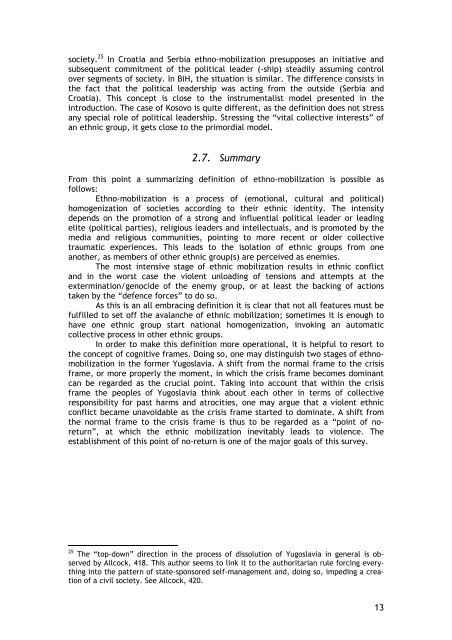Synthetic report - EURAC
Synthetic report - EURAC
Synthetic report - EURAC
You also want an ePaper? Increase the reach of your titles
YUMPU automatically turns print PDFs into web optimized ePapers that Google loves.
society. 25 In Croatia and Serbia ethno-mobilization presupposes an initiative and<br />
subsequent commitment of the political leader (-ship) steadily assuming control<br />
over segments of society. In BiH, the situation is similar. The difference consists in<br />
the fact that the political leadership was acting from the outside (Serbia and<br />
Croatia). This concept is close to the instrumentalist model presented in the<br />
introduction. The case of Kosovo is quite different, as the definition does not stress<br />
any special role of political leadership. Stressing the “vital collective interests” of<br />
an ethnic group, it gets close to the primordial model.<br />
2.7. Summary<br />
From this point a summarizing definition of ethno-mobilization is possible as<br />
follows:<br />
Ethno-mobilization is a process of (emotional, cultural and political)<br />
homogenization of societies according to their ethnic identity. The intensity<br />
depends on the promotion of a strong and influential political leader or leading<br />
elite (political parties), religious leaders and intellectuals, and is promoted by the<br />
media and religious communities, pointing to more recent or older collective<br />
traumatic experiences. This leads to the isolation of ethnic groups from one<br />
another, as members of other ethnic group(s) are perceived as enemies.<br />
The most intensive stage of ethnic mobilization results in ethnic conflict<br />
and in the worst case the violent unloading of tensions and attempts at the<br />
extermination/genocide of the enemy group, or at least the backing of actions<br />
taken by the “defence forces” to do so.<br />
As this is an all embracing definition it is clear that not all features must be<br />
fulfilled to set off the avalanche of ethnic mobilization; sometimes it is enough to<br />
have one ethnic group start national homogenization, invoking an automatic<br />
collective process in other ethnic groups.<br />
In order to make this definition more operational, it is helpful to resort to<br />
the concept of cognitive frames. Doing so, one may distinguish two stages of ethnomobilization<br />
in the former Yugoslavia. A shift from the normal frame to the crisis<br />
frame, or more properly the moment, in which the crisis frame becomes dominant<br />
can be regarded as the crucial point. Taking into account that within the crisis<br />
frame the peoples of Yugoslavia think about each other in terms of collective<br />
responsibility for past harms and atrocities, one may argue that a violent ethnic<br />
conflict became unavoidable as the crisis frame started to dominate. A shift from<br />
the normal frame to the crisis frame is thus to be regarded as a “point of noreturn”,<br />
at which the ethnic mobilization inevitably leads to violence. The<br />
establishment of this point of no-return is one of the major goals of this survey.<br />
25 The “top-down” direction in the process of dissolution of Yugoslavia in general is observed<br />
by Allcock, 418. This author seems to link it to the authoritarian rule forcing everything<br />
into the pattern of state-sponsored self-management and, doing so, impeding a creation<br />
of a civil society. See Allcock, 420.<br />
13

















